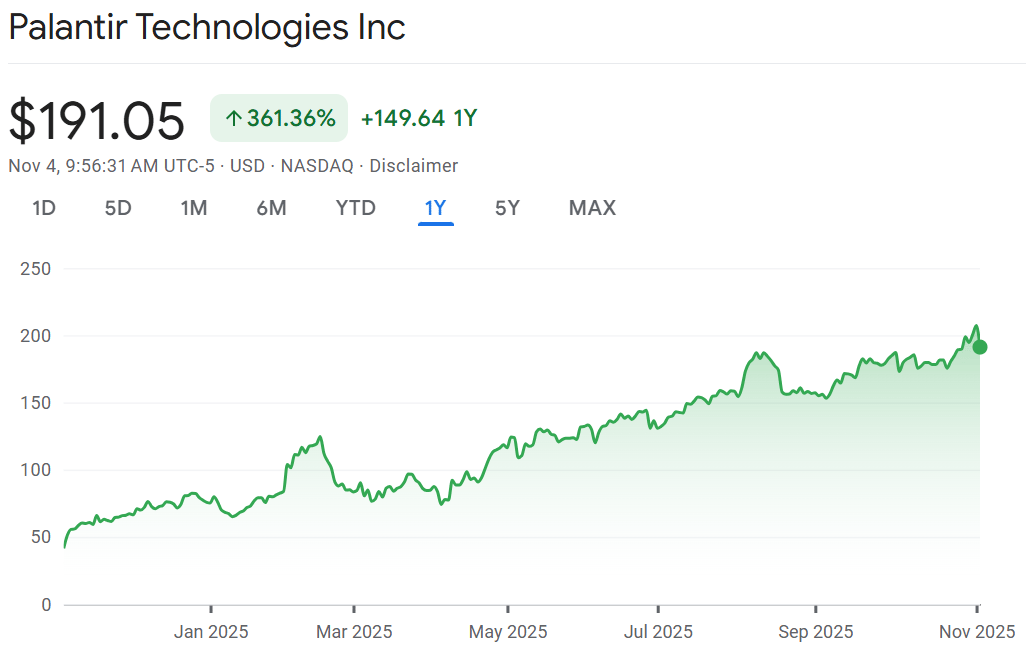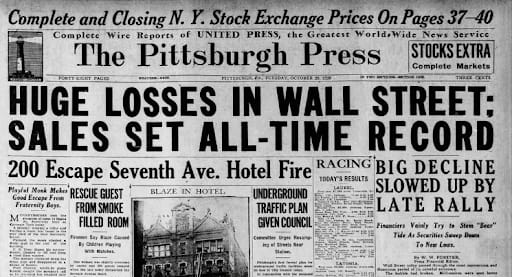- The Pragmatic Investor
- Posts
- Midweek Deep Dive: 🧠 Palantir’s 260× Valuation Makes Zero Sense
Midweek Deep Dive: 🧠 Palantir’s 260× Valuation Makes Zero Sense

🌞 Good Morning, Folks!
Something doesn’t add up this week. The market’s celebrating another round of “AI beats” like it’s free money, while valuations look like they’ve been pulled straight from 2021. Palantir jumps on earnings, analysts cheer the numbers, and everyone nods along as if 260× forward earnings is the new normal. It’s not. This isn’t rational optimism — it’s momentum disguised as conviction.
When everyone’s chasing the same theme, I like to stop and ask: what’s being ignored? Beneath the noise, there’s a widening gap between business results and investor expectations. And that gap — not the headlines — is what determines who makes money next quarter. In today’s issue, I’ll dig into one company that perfectly captures this tension. It’s a reminder that hype is temporary, but math always settles the score.
This week’s focus: Palantir — the AI darling that’s starting to look dangerous.
🌐 From Around the Web
A prominent VC argues that the current AI surge is fundamentally different from the dot-com bubble, citing real economic productivity, enterprise adoption, and infrastructure momentum. That’s a tough counterpoint to the “everyone knows it’s a bubble” narrative—and it matters, because doubting the doubters may create opportunities. If you write this off as hype, you may miss the part where value and scale converge.
This Motley Fool piece spotlights Netflix’s 10-for-1 stock split and nine other major growth names, suggesting a rotation towards under-owned, high-impact companies. The signal: the winners of tomorrow may not look like yesterday’s tech darlings. If you’re fixated on the usual suspects, you might miss the next front-line leaders.
Bitcoin slipped below a key $100,000 support level, shifting from “strong conviction asset” to “make-or-break signal” for crypto investors. When a crypto asset used as a hedge falters, it sends ripples through risk markets, not just digital currency. If you assume crypto’s momentum is unbreakable, you’re ignoring how quickly sentiment can flip.
TOGETHER WITH OUR PARTNER
Trusted by millions. Actually enjoyed by them too.
Most business news feels like homework. Morning Brew feels like a cheat sheet. Quick hits on business, tech, and finance—sharp enough to make sense, snappy enough to make you smile.
Try the newsletter for free and see why it’s the go-to for over 4 million professionals every morning.
🔍 This Week’s Focus: Palantir - The AI Darling That’s Starting to Look Dangerous

Every investor loves a good story — and Palantir just gave Wall Street one of its best yet.
Revenue up 62.8% year-over-year.
U.S. commercial growth exploding 121%.
Margins expanding to 33%.
It’s the kind of quarter that makes headlines, fuels Twitter threads, and gets retail investors rushing for the “buy” button.
But here’s what experience teaches you — the stories that sound perfect usually end badly.
And right now, Palantir feels less like a once-in-a-generation opportunity and more like a déjà vu moment from 2021 — when investors paid any price for a good narrative.
That’s why I’m not convinced.
Yes, the business is growing fast.
But at over 260× forward earnings, the stock isn’t just priced for perfection.
It’s priced for divinity.
Let’s cut through the noise and see what’s really going on.
🚀 The Growth Story Everyone’s Talking About
Let’s start with what Palantir absolutely nailed this quarter.
Revenue: Up 62.8% year-over-year, signaling strong execution.
Non-GAAP profit: $0.21 per share — beating estimates by over 25%.
Operating margin: Jumped to 33.3%, a clear sign of operating leverage kicking in.
U.S. revenue: Surged 77%, driven by corporate demand for its Artificial Intelligence Platform (AIP).
CEO Alex Karp called it “unrelenting AI demand” and the “transformational impact” of AIP.
He’s not exaggerating.
Palantir has positioned itself at the sweet spot between data, analytics, and artificial intelligence — turning complex enterprise data into usable intelligence.
For years, its strength was in defense and intelligence work. But now?
Corporate America is knocking.
From healthcare and finance to manufacturing, companies are integrating Palantir’s AIP to power decision-making and predictive models.
That’s a huge shift — and it’s real.
The U.S. commercial business is now the growth engine, and that’s the best kind of problem for a company like Palantir to have.
💰 The Numbers Are Beautiful — But Beauty’s Expensive
Let’s be honest — these numbers are sexy.
Margins up, profits up, growth up.
But there’s a darker side: valuation.
At 262× forward P/E, Palantir is priced higher than nearly every major tech name — including Microsoft, Nvidia, and Snowflake.
Let that sink in.
You’re paying more for Palantir’s potential than for Nvidia’s actual dominance.
And that’s where the math stops making sense.
This stock is trading as if it will flawlessly execute for the next decade — no competition, no setbacks, no macro slowdown.
That’s not investing.
That’s faith-based finance.
Even Palantir bulls will tell you: the business is excellent, but the stock is walking on air.
When the narrative starts driving valuation more than earnings, you’re buying hope — and hope doesn’t compound.
⚙️ What’s Working (and Why It Matters)
Here’s where Palantir deserves real credit: it’s finally scaling what once looked unscalable.
Commercial explosion: 121% growth in U.S. commercial revenue — a massive validation of the AIP product.
Government stability: Defense and intelligence contracts remain sticky and recurring.
Diversification: Expansion into healthcare, energy, and manufacturing sectors.
Customer stickiness: Once Palantir integrates, clients rarely leave — its systems become mission-critical.
This is exactly what long-term investors want to see — a company evolving beyond a niche defense contractor into a broad enterprise software platform.
But there’s a trade-off: growth of this kind takes customization, manpower, and time.
Palantir isn’t selling plug-and-play SaaS; it’s selling deep integration. That means growth will eventually slow as the company bumps into scalability limits.
And when growth slows — even slightly — the market will reprice the dream.
⚠️ The $60-Billion Question Nobody’s Asking
Why does a company with under $3 billion in annual revenue trade like a trillion-dollar juggernaut?
Because the market’s drunk on AI.
Everyone wants exposure. Everyone wants the next Nvidia.
And Palantir happens to be one of the few “AI pure plays” with a real product and real profits.
That’s why the market keeps bidding it up — even when logic says otherwise.
But here’s the uncomfortable truth: valuation still matters.
It always does.
At some point, buyers will stop paying 262× for growth that can’t stay triple-digit forever.
When that happens, momentum turns into quicksand.
And the same investors chasing today’s breakout will be the first to dump shares when growth slows to 30–40%.
That’s how hype cycles end — not with panic, but with silence.
🧮 The Rule of 40 Reality Check
Let’s test Palantir against the Rule of 40 — the golden metric for software companies.
Growth rate + profit margin ≥ 40%.
Right now, Palantir clears it easily:
~60% growth + 33% margin = 93%.
That’s elite.
But it also sets a trap.
Once you’re this far above the threshold, there’s only one direction left to go.
If growth slows or margins plateau, that score drops fast — and so does the multiple.
This is what I call the gravity effect.
When a company flies too high on perfect metrics, even small changes feel catastrophic.
Investors price in a fantasy, and reality eventually interrupts.
💡 My Take: Great Company, Dangerous Price

If you already own Palantir — congratulations. You caught a rocket.
But if it were my portfolio? I’d be trimming.
Here’s how I’d think about it:
If you’re in profit: Lock some gains. Don’t sell all — just remove your emotion from the position.
If you’re on the sidelines: Be patient. Wait for a 20–25% pullback or a reset in valuation.
If you’re tempted to chase: Ask yourself, “Am I buying the business or the story?”
Because right now, it’s all story.
This is the moment where smart investors get cautious — not greedy.
The numbers justify admiration, not acceleration.
🧠 The Psychological Game: Hope vs. Fear
Palantir triggers every investor bias known to man — FOMO, confirmation bias, narrative attachment.
AI! Government contracts! Explosive growth!
It sounds unstoppable.
But that’s exactly when seasoned investors step back.
Remember: losses hurt twice as much as gains feel good.
That’s how your brain’s wired.
And when valuations are this stretched, one bad headline or a slower guidance can erase months of paper gains overnight.
Markets don’t reward dreamers forever.
They reward realists who wait for emotion to drain from the price chart.
TOGETHER WITH OUR PARTNER
Crash Expert: “This Looks Like 1929” → 70,000 Hedging Here
Mark Spitznagel, who made $1B in a single day during the 2015 flash crash, warns markets are mimicking 1929. Yeah, just another oracle spouting gloom and doom, right?
Vanguard and Goldman Sachs forecast just 5% and 3% annual S&P returns respectively for the next decade (2024-2034).
Bonds? Not much better.
Enough warning signals—what’s something investors can actually do to diversify this week?
Almost no one knows this, but postwar and contemporary art appreciated 11.2% annually with near-zero correlation to equities from 1995–2024, according to Masterworks Data.
And sure… billionaires like Bezos and Gates can make headlines at auction, but what about the rest of us?
Masterworks makes it possible to invest in legendary artworks by Banksy, Basquiat, Picasso, and more – without spending millions.
23 exits. Net annualized returns like 17.6%, 17.8%, and 21.5%. $1.2 billion invested.
Shares in new offerings can sell quickly but…
*Past performance is not indicative of future returns. Important Reg A disclosures: masterworks.com/cd.
🧠 What did you think of today's newsletter? |
🧠 Final Word
Lately, markets feel louder than ever. Every earnings call, every CEO quote, every headline has the same echo: AI will change everything. You can almost feel the collective adrenaline — investors chasing what’s hot, funds front-running momentum, retail piling in late. It’s intoxicating to watch, but also dangerous. When optimism becomes the default setting, that’s when I start to worry. Because markets don’t just correct numbers — they correct emotion.
I’ve seen this movie before. Hype always burns bright before it burns out. The investors who win aren’t the loudest; they’re the ones quietly taking profits while everyone else celebrates. Patience isn’t weakness — it’s strategy. Let others chase headlines and short-term validation. I’d rather wait for prices to cool, for emotion to drain, and for logic to return. Because when it does, value re-emerges — and that’s when the calm, pragmatic investor steps back in while the crowd looks away.
Stay Sharp,
— AK

Disclaimer: The content on this blog is for educational and informational purposes only and is not intended as financial, investment, tax, or legal advice. Investing in the stock market involves risks, including the loss of principal. The views expressed here are solely those of the author and do not represent any company or organization. Readers should conduct their own research and due diligence before making any financial decisions. The author and publisher are not responsible for any losses or damages resulting from the use of this information.



Reply